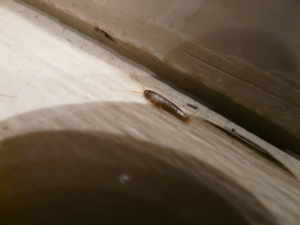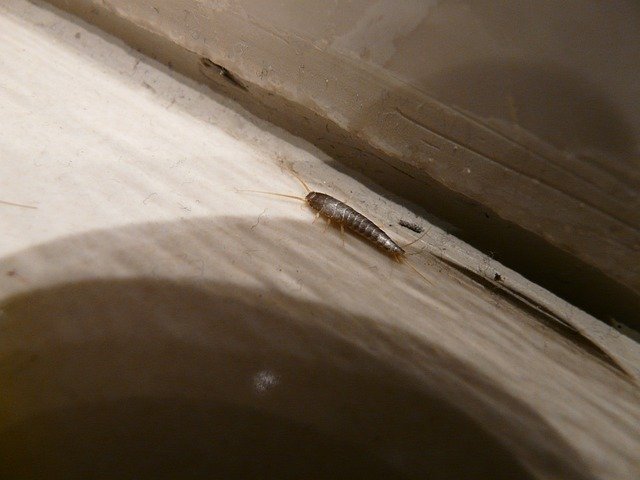Indice
- What Are Silverfish? An Introduction to These Prehistoric Pests
- Physical Characteristics and Identification of Silverfish
- Habitat and Behavior: Where Silverfish Thrive
- The Silverfish Diet: What These Insects Eat
- Potential Health Risks Associated with Silverfish Infestations
- Property Damage Caused by Silverfish: Books, Clothes, and More
- The Ecological Role of Silverfish: Are There Any Benefits?
- Preventing Silverfish Infestations: Proactive Measures
- Natural Remedies for Eliminating Silverfish
- Chemical Treatments and Professional Pest Control Options
- Long-term Silverfish Control: Maintaining a Pest-Free Home
- Conclusion: Living Harmoniously in a Silverfish-Free Environment
What Are Silverfish? An Introduction to These Prehistoric Pests
Origins and Characteristics
Silverfish, scientifically known as Lepisma saccharinum, are small, wingless insects that have existed for over 400 million years, earning them the title of “prehistoric pests.” They typically measure between 1/2 to 1 inch in length and are recognizable by their silvery, metallic appearance and elongated, teardrop-shaped bodies. Their three long, tail-like appendages at the rear help distinguish them from other common household insects. Silverfish thrive in warm, humid environments, making kitchens, basements, and bathrooms their preferred habitats.
Behavior and Life Cycle
Silverfish are nocturnal creatures, coming out primarily at night to forage for food. They are agile and can move rapidly, often seeking refuge in cracks, crevices, and behind baseboards during the day. The life cycle of a silverfish typically spans two to eight years, during which females lay eggs in hidden places. Nymphs hatch from these eggs and look similar to adults but are smaller and lack the silvery sheen. It can take several molts for them to develop into mature silverfish.
Diet and Feeding Habits
Silverfish are primarily detritivores, meaning they feed on organic matter. Their diet includes starchy substances, such as paper, glue, book bindings, and even dead insects. This propensity for eating cellulose-based products often leads them into homes where they can cause damage to books, photographs, wallpaper, and other materials. Interestingly, these pests are not harmful to humans or pets, but their presence indicates moisture problems and can contribute to damage if not managed properly.

Physical Characteristics and Identification of Silverfish
Size and Shape
Silverfish are small insects that typically range from 1/2 inch to 1 inch in length. Their bodies are elongated and teardrop-shaped, which gives them a streamlined appearance. The silvery grey color, resembling polished metal, is one of their distinctive features, setting them apart from other household pests. This unique shape and coloration help them scuttle quickly across surfaces and seek refuge in tight spaces.
Body Structure and Appendages
One of the notable characteristics of silverfish is their body structure. They have a soft exoskeleton covered in scales, enhancing their shiny appearance. Additionally, silverfish possess three long, tail-like appendages at the rear, along with two antennae that can be as long as their bodies. These appendages not only aid in mobility but also play a significant role in their sensory perception, helping them navigate their environments, particularly in dark and hidden spaces.
Distinguishing Features
To accurately identify silverfish, it’s essential to note their unique movements and behavior. Unlike many other insects, silverfish move in a wiggling, fish-like manner, which is where they get their name. They are known for their swiftness and ability to evade capture. When frightened, silverfish may also curl up or play dead, enhancing their chances of survival. Being able to recognize these characteristics can help homeowners identify silverfish in their living spaces before an infestation becomes unmanageable.
Habitat and Behavior: Where Silverfish Thrive
Preferred Environments
Silverfish thrive in environments that are warm, dark, and humid. Their ideal habitat includes areas with high moisture content, such as basements, bathrooms, and kitchens. These spaces, often a byproduct of plumbing leaks or inadequate ventilation, provide silverfish with the moisture they need to survive. They can often be found hiding in cracks, crevices, and behind furniture, making them difficult to spot until an infestation is present.

Activity Patterns
As predominantly nocturnal creatures, silverfish are most active at night when they venture out in search of food. They are agile insects capable of moving quickly, which helps them evade predators and find refuge during the day. Silverfish utilize their sensitive antennae to navigate through their surroundings, relying on vibrations and chemical cues to locate food sources and suitable nesting spots. This behavior not only aids in their foraging but also helps them conserve energy while remaining hidden from potential threats.
Social Behavior
While generally solitary, silverfish may sometimes be found in small groups, particularly in favorable environments that provide ample food and moisture. They do not exhibit a complex social structure like some other insects; instead, their interactions are primarily driven by the search for resources. The presence of silverfish in larger numbers can indicate a more significant moisture problem in the home, prompting homeowners to address the environmental conditions that allow these pests to thrive. Recognizing their behavioral patterns can help in identifying potential problem areas and implementing effective control measures.
The Silverfish Diet: What These Insects Eat

Primary Food Sources
Silverfish are primarily detritivores, which means their diet consists mainly of organic matter, particularly those rich in carbohydrates and proteins. They are drawn to starchy foods, notably paper, cardboard, and the adhesive used in book bindings. Silverfish are also known to consume dead insects, fungi, and even certain types of grains, making their feeding habits quite varied. This omnivorous diet allows them to thrive in various environments, particularly in homes where such food sources are abundant.
Nutritional Requirements
For optimal health, silverfish require a continuous supply of carbohydrates and proteins. Their preference for starchy substances is not merely about sustenance but is essential for their growth and reproduction. Silverfish leverage the cellulose found in plant matter as a significant part of their diet, which they digest with the help of symbiotic microorganisms. This adaptability in their dietary needs enables them to survive in various habitats, contributing to their persistence in human dwellings.
Impact of Diet on Infestations
The feeding habits of silverfish can lead to significant damage in homes, particularly in areas where books, papers, and textiles are present. As they consume these materials, they may leave behind small holes or notches, leading to unsightly damage. Their affinity for starchy materials often brings them into contact with stored food products, although they do not typically eat them. Homeowners should be vigilant about maintaining dry and clean conditions to deter silverfish, as their presence can often indicate underlying moisture problems that could lead to more severe infestations. Regular cleaning and proper storage of food and paper products can help mitigate the risk of attracting these pests.
Potential Health Risks Associated with Silverfish Infestations
Allergic Reactions
While silverfish themselves do not pose a direct threat to human health, their presence can lead to allergic reactions in sensitive individuals. Silverfish are known to shed scales, feces, and body parts, which can become airborne and trigger allergies or asthma in some people. Symptoms may include sneezing, coughing, skin irritations, and respiratory issues. Individuals who are already prone to allergies should be particularly cautious and consider seeking professional pest control assistance to reduce the risk of exacerbating their conditions.
Indirect Illness Risks
Silverfish can contribute to unhealthy living conditions in homes, particularly by indicating high levels of moisture. These pests thrive in damp environments, which can also be conducive to mold growth and other pests, such as dust mites. Mold can lead to respiratory problems, allergic reactions, and other serious health concerns. When a silverfish infestation suggests underlying moisture issues, it’s essential for homeowners to address these conditions promptly to ensure a healthy living space. Regularly monitoring and managing humidity levels can help mitigate these risks effectively.
Food Contamination Concerns
Although silverfish are not known to directly harm stored food products, their scavenging habits can lead to contamination. They may be attracted to food packaging and can leave behind traces of waste, which can compromise hygiene standards. For households that prioritize food safety, the presence of silverfish can be alarming. It is important to store food in airtight containers and maintain a clean environment to discourage not only silverfish but also other pests that can pose health risks. Implementing proactive measures will help ensure that food remains uncontaminated and safe for consumption.
Property Damage Caused by Silverfish: Books, Clothes, and More

Damage to Books and Paper Products
One of the most significant impacts of a silverfish infestation is the damage they inflict on books and paper products. These pests are particularly attracted to the cellulose found in paper, which they consume with enthusiasm. Over time, silverfish can leave visible trails of destruction, including small holes and notches in pages. This not only diminishes the aesthetic value of books but can also render them unreadable, leading to the loss of valuable information or cherished collections. Libraries and homes alike should maintain dry conditions to mitigate silverfish attraction and protect paper materials from these relentless pests.
Impact on Clothing and Fabrics
Silverfish are notorious for their appetite for starches, which makes them a threat to a variety of fabrics, including clothing, upholstery, and curtains. They may chew through natural fibers such as cotton, linen, and even some synthetics, resulting in unsightly damage and costly replacements. Infestations often go unnoticed until extensive damage has occurred, as silverfish tend to prefer dark, hidden areas for nesting. Regular inspection of closets and storage areas, along with proper clothing storage in airtight containers, can help minimize the risk of silverfish damage to fabrics.
Effects on Household Items and Structures
Beyond just books and clothing, silverfish can also damage a range of household items and structures. They may chew on wallpaper, photographs, and even stored food items, though they do not usually consume the food itself. This damage can lead to costly repairs and replacements for homeowners. Furthermore, the presence of silverfish indicates possible moisture issues in the home, which can lead to more extensive problems, such as structural damage due to mold or weakened building materials. Addressing these moisture issues promptly is crucial to protect your home from the secondary effects of silverfish infestations and the damages they can cause.
The Ecological Role of Silverfish: Are There Any Benefits?

Decomposers in Ecosystems
Silverfish play a crucial role in the ecosystem as decomposers. By feeding on decomposing organic matter, including dead plants, leaves, and even the remains of other insects, they help break down these materials and facilitate nutrient recycling back into the soil. This process enriches the soil, promoting healthier plant growth and contributing to the overall balance of the ecosystem. By turning organic waste into usable nutrients, silverfish significantly support the functioning of various terrestrial habitats.
Indicators of Moisture Issues
While often seen merely as pests, silverfish can serve as indicators of underlying moisture problems within homes or other structures. Their presence typically signifies high humidity or damp conditions, which could lead to more severe issues, such as mold growth or structural damage. By identifying and addressing the factors that attract silverfish, homeowners can mitigate potential health risks related to mold and improve their indoor environment. In this way, silverfish act somewhat as environmental monitors, drawing attention to moisture levels that may require intervention.
A Food Source for Other Organisms
Silverfish also contribute to the food web by being a source of nourishment for various predators. Small mammals, birds, and other insectivores may prey on silverfish, which helps to maintain a balanced ecosystem. In this regard, silverfish are integral to the biodiversity of their habitats, providing sustenance for other species within the food chain. Their role in the ecosystem highlights the interconnectedness of organisms and the importance of even the smallest species in maintaining ecological balance.
Preventing Silverfish Infestations: Proactive Measures
Maintain Low Humidity Levels
One of the most effective ways to prevent silverfish infestations is to maintain low humidity levels in your home. Silverfish thrive in moist environments, so using dehumidifiers in areas prone to dampness, such as basements and bathrooms, can significantly reduce their appeal. Regularly monitoring humidity levels with a hygrometer and using exhaust fans in kitchens and bathrooms can help keep the moisture in check. Sealing any leaks and ensuring good ventilation will further mitigate conditions that attract silverfish.
Proper Food Storage and Cleanliness
To deter silverfish, it is essential to store food items properly and maintain a clean environment. Keep food in airtight containers to prevent access, and make it a habit to clean up spills and food crumbs promptly. Regularly decluttering and vacuuming areas where paper products, textiles, or debris accumulate can eliminate potential food sources for these pests. Paying particular attention to hiding spots, such as under sinks and behind appliances, will help mitigate the risk of infestations.
Seal Cracks and Crevices
Silverfish can easily enter homes through tiny cracks and crevices, making it vital to seal any potential entry points effectively. Inspect your home for gaps around windows, doors, and foundational cracks, and use caulk or weather stripping to close them off. Additionally, installing door sweeps can prevent silverfish from entering through gaps underneath doors. By creating a physical barrier, you can significantly reduce the chances of these pests infiltrating your living spaces.
Regular Inspections
Conducting regular inspections of your home can help you detect any early signs of silverfish infestation before it escalates. Look for signs such as shed skin, small holes in fabrics, or visible silverfish in dark, damp areas. If signs of silverfish are observed, taking immediate action with targeted measures can prevent a larger problem. By staying vigilant and proactive, homeowners can address issues promptly and maintain a pest-free living environment.
Natural Remedies for Eliminating Silverfish
Essential Oils as Deterrents
Essential oils, particularly those derived from peppermint, lavender, and citrus, can effectively repel silverfish. The strong scents of these oils disrupt the silverfish’s ability to navigate and find food. To utilize this natural remedy, mix a few drops of essential oil with water in a spray bottle and apply the solution in areas where silverfish are likely to appear. Regularly refreshing this spray can help maintain its efficacy and create an unpleasant environment for these pests, encouraging them to seek food elsewhere.
Using Diatomaceous Earth
Diatomaceous earth (DE) is a natural insecticide made from fossilized algae. Its fine powdery texture is lethal to silverfish, as it can damage their exoskeletons, leading to dehydration. To use diatomaceous earth, sprinkle a thin layer in areas where silverfish are often seen, such as along baseboards, in cracks, and around furniture. This remedy is safe for use around pets and humans, but it’s essential to avoid inhaling the dust during application. Reapply as needed, especially in damp areas, to maintain its effectiveness.
Homemade Traps
Crafting homemade traps can help you catch and eliminate existing silverfish in your home. One simple method involves using a jar with a piece of bread at the bottom. The bread serves as bait, and when silverfish crawl in, they have difficulty getting back out due to the smooth sides of the jar. Place these traps in areas where you suspect silverfish activity, such as basements, kitchens, and bathrooms. Check and dispose of any captured silverfish regularly to keep your home pest-free.
Chemical Treatments and Professional Pest Control Options
Understanding Chemical Treatments
Chemical treatments for silverfish infestations typically involve the use of insecticides that target these pests specifically. Common active ingredients in these insecticides include pyrethroids, which are derivatives of natural pyrethrins and are known for their effectiveness against a broad range of insects, including silverfish. However, caution should be exercised when applying chemical treatments, particularly in homes with children or pets. It’s vital to follow the manufacturer’s instructions meticulously to ensure safety and effectiveness, as improper use can lead to unnecessary exposure to toxic substances.
Professional Pest Control Services
For severe infestations or if DIY methods are ineffective, enlisting the help of professional pest control services may be the best course of action. Pest control professionals can conduct a thorough inspection to identify the extent of the infestation and determine the appropriate treatment methods tailored to your specific situation. They often employ a combination of chemical and non-chemical approaches, utilizing advanced techniques and products that may not be available over the counter. Professional treatments may include sealing entry points, deploying traps, and applying targeted insecticides to eliminate all stages of the silverfish lifecycle.
Integrating Chemical and Non-Chemical Strategies
Effectively managing silverfish infestations often requires a multifaceted approach that combines chemical and non-chemical strategies. In addition to employing insecticides, homeowners should supplement their efforts with preventive measures, such as maintaining low humidity, regular cleaning, and sealing cracks and crevices. By removing food sources and moisture that attract silverfish, along with utilizing targeted chemical treatments, homeowners can create an inhospitable environment for these pests while enhancing the effectiveness of their pest control strategies. Regular monitoring and proactive management are essential to ensure long-term success in keeping silverfish at bay.
Long-term Silverfish Control: Maintaining a Pest-Free Home
Creating an Unwelcoming Environment
To achieve long-term control of silverfish, it’s essential to create an environment that is unwelcoming to these pests. This begins with addressing moisture issues, as silverfish thrive in humid conditions. Homeowners can invest in dehumidifiers for basements, bathrooms, and kitchens to keep humidity levels below 50%. Regularly cleaning gutters, ensuring proper ventilation in crawl spaces, and promptly fixing leaks can further reduce moisture accumulation. Additionally, limiting clutter where silverfish can hide, such as old newspapers and cardboard boxes, helps discourage infestations.
Regular Maintenance and Inspections
Establishing a routine for regular maintenance and inspections can be an effective strategy in preventing silverfish rehousing. Homeowners should thoroughly inspect areas prone to infestations, such as attics, basements, and behind appliances, at least every six months. Look for signs such as shed skins, droppings, or damage to paper products and fabrics. By catching infestations early, proactive measures can be taken before the problem escalates. Regular vacuuming and dusting can also help eliminate potential food sources and decorative items that may attract silverfish.
Implementing Integrated Pest Management (IPM) Strategies
Integrated Pest Management (IPM) approaches combine multiple strategies to control pest populations effectively. For silverfish, this means using a combination of cultural, mechanical, and chemical methods to deter and eliminate infestations. Homeowners can employ mechanical traps, establish barriers by sealing cracks and crevices, and, if necessary, use targeted insecticides. Educating household members about practices that attract silverfish—such as leaving food out or neglecting to clean up crumbs—will foster a united front in your pest control efforts. This holistic approach not only helps maintain a clean and healthy environment but also minimizes the reliance on chemicals, making it safer for families and pets.
Conclusion: Living Harmoniously in a Silverfish-Free Environment
Emphasizing Prevention and Maintenance
To successfully coexist with our environments free of silverfish, maintaining a proactive approach is crucial. Regularly implementing preventive measures such as controlling humidity levels, proper food storage, and routine cleaning significantly reduces the chances of attracting silverfish. Homeowners should also engage in frequent inspections to identify signs of infestation early on. By addressing potential entry points and creating less favorable conditions, the likelihood of an infestation can be minimized, leading to a healthier home environment.
Education and Awareness
Raising awareness about silverfish and their habits is vital for effective pest management. Understanding their biological traits, dietary preferences, and environmental needs empowers homeowners to act decisively against these pests. Community education initiatives can help inform individuals about the significance of timely action to prevent infestations. Moreover, knowledge of natural and chemical remedy options gives homeowners the tools necessary to eliminate silverfish effectively and sustainably.
Seeking Professional Help When NecessaryWhile many infestations can be managed through home remedies and preventive strategies, some cases may require professional pest control services, especially in severe infestations. Trained experts can accurately assess the situation and implement a comprehensive plan, ensuring long-term results. Homeowners should not hesitate to seek assistance when faced with persistent silverfish issues. By combining professional intervention with personal preventative efforts, families can achieve a harmonious living space free from the nuisances of silverfish.





